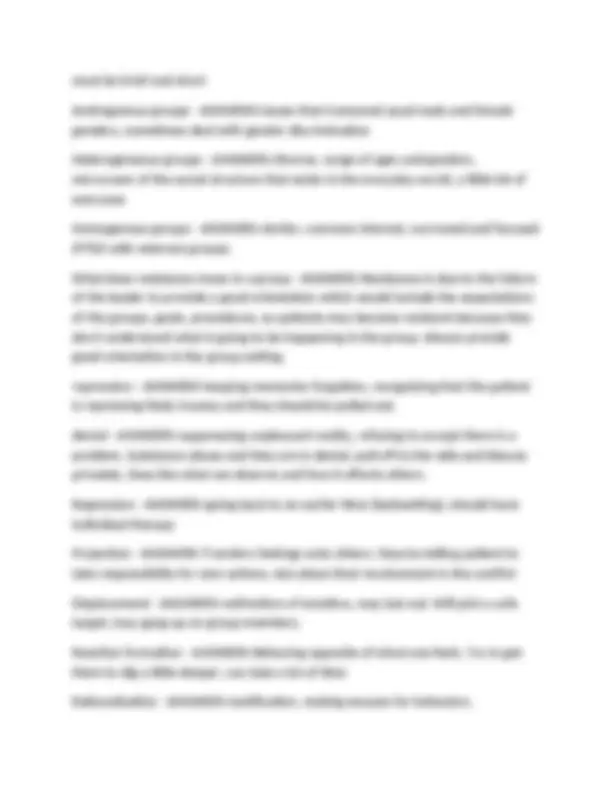





Study with the several resources on Docsity

Earn points by helping other students or get them with a premium plan


Prepare for your exams
Study with the several resources on Docsity

Earn points to download
Earn points by helping other students or get them with a premium plan
Community
Ask the community for help and clear up your study doubts
Discover the best universities in your country according to Docsity users
Free resources
Download our free guides on studying techniques, anxiety management strategies, and thesis advice from Docsity tutors
NURS 661 EXAM 2 QUESTIONS AND ANSWERS 2025 LATEST UPDATE GRADED A+ PASS. NURS 661 EXAM 2 QUESTIONS AND ANSWERS 2025 LATEST UPDATE GRADED A+ PASS.
Typology: Exams
1 / 7

This page cannot be seen from the preview
Don't miss anything!




Blocking - ANSWERS-stop counterproductive behavior of patient without attacking them Empathiizing - ANSWERS-Convey understanding, grasp patients world, identify with them by their frame of reference Evaluating - ANSWERS-Assess behavior, assess group progress, ongoing after each session Facilitating - ANSWERS-enabling members withing the group, open up communication, help members to increase responsibility Giving Feedback - ANSWERS-Help direct clients so they can reach their goals Goal setting - ANSWERS-the process of working toward something you want to accomplish Inititating - ANSWERS-Bring new ideas to the group, initiate effective group progress Reflecting Feelings - ANSWERS-Let members of the group know they are being heard and understood Suggesting - ANSWERS-Offer advice leading to a point Interpreting - ANSWERS-Possible explanations for certain thoughts, feelings or behaviors, trying to make them aware of potential conflicts or contradictions Risks Associated with Group Work - ANSWERS-Patients doing worse, confidentiality, safety, confrontation, one group member ganging up on another, intimidation Who warns about potential risks in group work? - ANSWERS-The leader Benefits of group work - ANSWERS-social support, getting perspectives from
others, learning other adaptive behaviors, learn coping skills Major goals of group work - ANSWERS-To resolve our own conflict, change is possible, learn coping skills, things can change and get better but may be rough in the beginning, give them hope How does informed consent relate to group work - ANSWERS-Notifies the clients what to expect and the guidelines and they agree to participate, discuss potential problems. Appropriate both legally and ethically to warn the client that they may be uncomfortable and there could be confrontation. What is an encounter group - ANSWERS-An enactment of here and now but related to past or future event How is group counseling different - ANSWERS-preventative and educations purposes using the here and now (shorter) How is group therapy different - ANSWERS-Remediation of past problems/difficulties (longer) What is the major difference between group counseling and group therapy - ANSWERS-Different goals How are psychotherapy groups different - ANSWERS-Education including past and present How are self-exploration groups different - ANSWERS-About personal growth, experience and self-awareness groups, as leaders its a good idea for us to do them How are task groups different - ANSWERS-designed to assist task forces, committee, big projects How are psychoeducational groups different - ANSWERS-They have a central theme, more structured, specific How has managed care affected brief interventions and short-term groups - ANSWERS-Need to get them done fast and cost-effective, therapies and groups
What happens in Stage 1 - Pregroup Issues - ANSWERS-formation, screening people, picking people, getting prepared, setting things up What happens in stage 2 - initial stage - ANSWERS-orientation and exploration, structure of group, getting acquainted and building trust- most important in any therapeutic relationship - trust Stage 3 - Transition - ANSWERS-dealing with resistance and reluctance, dealing with conflict that may arise Stage 4 - Working stage - ANSWERS-cohesion and productivity, things are happening Stage 5 - Final stage - ANSWERS-Consolidation, termination, using what they learned in the group in their everyday life Stage 6 - evaluation - ANSWERS-post group issues What is the most important thing to develop in a group setting - ANSWERS-Trust What is a cathartic experience - ANSWERS-Strong emotional purging that provides relief like crying which therapies is catharsis important in? - ANSWERS-psychodrama How does a patient end up with a cathartic experience in psychodrama - ANSWERS-During the acting What do we need to help patients with after a cathartic experience - ANSWERS- processing the emotion and self-awareness by doing cognitive restructuring What is free association and how is it used in a group setting - ANSWERS-No filter, say how you feel. Let them go and say what comes to mind and then discuss it later Which group is free association used in most often - ANSWERS-psychoanalytic and psychodynamic Roles in psychodrama - ANSWERS-Protagonist - person with the problem
leader - helping person with the problem audience - looking at the problem from the outside Role and function of the group leader - ANSWERS-facilitating, giving support, providing balance, helping to face resistance What is the function of the group members - ANSWERS-Setting goals and boundaries, should be helping with resistance, keeping group on point. What is interpretation - ANSWERS-Analysis of free associations, dreams, resistance and transference feelings Who does interpretations in the group - ANSWERS-Typically the leader but technically everybody can. Wouldn't be the group members on the sideline, they aren't really involved so they can't make an interpretation. Can be done in the group right then and there or individually later on. Transference in psychoanalytic group - ANSWERS-Clients projecting feeling onto the leader. We want to try and figure out what past behaviors are causing them to have transference behaviors. countertransference - ANSWERS-therapist taking their feelings onto the patient What is psychoanalytic dream work - ANSWERS-interpreting dreams to uncover unconscious What is brief psychodynamic therapy and which patients is it most appropriate for
What is physical action in psychodrama - ANSWERS-physical action instead of talking to make abstract situations more concrete, self-presentation Self-presentation in psychodrama - ANSWERS-protagonist gives a self-portrait to introduce the situation role reversal in psychodrama - ANSWERS-most powerful, looking at oneself through another individuals eye/ protagonist plays another role Double in psychodrama - ANSWERS-auxiliary playing a special role. Auxiliary is playing the role of the protagonist and their self Soliloquy in psychodrama - ANSWERS-protagonist expresses their feeling at that moment in time empty chair in psychodrama - ANSWERS-pretend like someone is in the chair future projection in psychodrama - ANSWERS-act out a future event for a patient Replay in psychodrama - ANSWERS-redo the act or scene role training in psychodrama - ANSWERS-systemic use of techniques Players roles in psychodrama - ANSWERS-Protagonist - main player, focus of the psychodramatic reenactment, selects the event. Supportive (auxiliary) plays a supporting role in the drama Audience - no role but acts as a mirror giving the protagonist the experience of knowing that others share in looking at the world from their point of view.